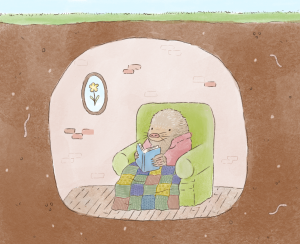Mole in a Hole by Indira Mishra
There is a mole that lives in a hole.

From his hole, he can walk to Superstore, or he can walk to the forest. Superstore is a 5-minute walk as the crow flies, but a 14-minute walk on pavement.
The mole can walk to Superstore and buy Maltesers when the snow has melted. The city doesn’t clear the street outside his mole hole, and one day while walking to Superstore, he slipped on hardened snow. Although he wasn’t injured, he decided that walking isn’t worth risking one’s life.
The mole doesn’t like that he has to drive everywhere in winter. It seems silly to drive when he has perfectly good legs. But he is very grateful to have a car. And he is very grateful to have perfectly good legs. He knows that if he didn’t have a car, he would have to take the bus. And taking the bus takes 3 times longer than driving.
In winter, especially, he barely walks. He walks to the car, drives to Superstore, walks to the candy aisle to get Maltesers. He walks to the car, drives to the forest, walks in the forest.
The forest is not a forest; it is a park. If he walks deep enough into the park, the road escapes from view and he can see only trees, so he pretends it is a forest. But the forest is dirty. It is filthy with noise. Traffic noise creeps in through the barren winter branches. Real forests do not have traffic noise. Some days he walks in the forest without noticing the traffic noise. And then he feels guilty, complicit, and corrupted.
The mole always drives to school because it is too far to walk, even on days without snow. It takes 11 minutes to drive to school. It would take 1 hour and 43 minutes to walk to school.
The school is on a hill. The hill is next to a droning highway. Many of the students at school live on the hill. Sometimes the mole is a little sad that he lives in a hole and not on the hill. If he lived on the hill, he would live near so many other students, and maybe he could have more friends.
After school, the mole hurries back to his hole and burrows in the dark underground. Even deep in the earth, he can hear car horns honking on the street above. At times when it seems perfectly quiet, he still fears that traffic noise is always present, but that he can no longer consciously hear it because it is now part of him.
The mole is very grateful.
He knows he is very privileged to have a school, a car, and a warm hole to live in. The mole feels so grateful for the things that he has that sometimes he bursts into tears. And once all his tears have depleted, he feels empty.
One year, the mole wins a scholarship to live in a new city and go to a new school. He moves across the country to live in a flat above ground. Not just above ground, but a whole floor above ground with a big window overlooking the street. He still calls it a hole because that is what moles call their homes, underground or otherwise.

In his first week in the new city, he walks 20 minutes from his hole to the base of a bare hill. He climbs 80 stories of elevation to the top of the hill. He climbs to the top of the world, the city that is his new world. As he stands on that seat, high above the city, he looks down and sees every building and every street. He can see every walking person, every bus, and every car. But from all the way up there, he can’t hear any of it at all.
In his new home, the mole hole a whole floor above ground, he hears traffic noise constantly from the busy street below. At first, it bothered him. But he soon realized that he’d rather hear traffic noise in his hole than when he’s walking in the forest. Because it means he can walk to more than just Superstore and a forest. He can walk to the café, and he can walk to the shop where he buys Maltesers, and he can walk to his friends’ houses, and he can even walk to school.
Most days, the mole feels content.
And when he sits with his friends in the café, or goes to an event at school, or lets the sun warm his face, or is tired out at the end of the day from so much walking, he even feels happy.
The mole wondered for a long time what he did differently in this new place to deserve to feel happy. In the end, he decided it was nothing. Maybe the reason he never felt right in that old place was that the place he belonged was always here, waiting for him.
Even as content as the mole is, he often thinks of the trees in the old park. He misses disappearing behind the branches and pretending to be alone in the forest. On these days, he walks 20 minutes to the base of the bare hill and climbs to the top. He looks down at the city that is the world, down at his new hole, and his new school, and the shop where he shops, and the streets where he walks. Because on the hill, it’s truly quiet.
About the Contributor
Indira Mishra will be graduating from UBCO with her Bachelor of Science in mathematics. She has a lifelong passion for reading which inspires her writing. Her short story Mole in a Hole examines loneliness, isolation, and the power that a place has in affecting an individual’s connection to a community and the world around them.
Illustrations by Indira Mishra

